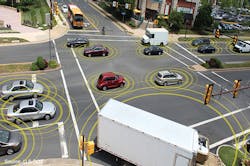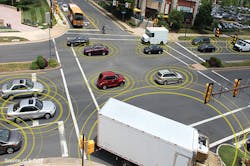DSRC vs. C-V2X: Looking to Impress the Regulators (.PDF Download)
Most like a good scuffle, whether it takes the form of combat sports—“Everyone loves a fight," says Ultimate Fighting Championship (UFC) president Dana White, "it's in our DNA.”—or two technology camps vying to become an industry (or de facto) standard. A good example of the latter is the ongoing tiff between Wi-Fi-based 802.11p and cellular’s C-V2X technology, as they vie to represent vehicle-to-everything (V2X) communications on a global basis.
Currently, two key sets of standards for V2X communication exist, namely dedicated short-range communications (DSRC) in the U.S. and the Cooperative Intelligent Transport (C-ITS) standards in Europe. DSRC is a U.S. Department of Transportation (DoT) project based on the Communications Access for Land Mobiles (CALM) architecture for vehicle-based communication networks. On December 17, 2003, the FCC adopted a Report and Order establishing licensing and service rules for the DSRC Service in the Intelligent Transportation Systems (ITS) Radio Service occupying the 5.850- to 5.925-GHz band (5.9-GHz band).
What Exactly is DSRC?
The ultimate vision of DSRC is a nationwide network that enables communications between vehicles and roadside access points or other vehicles (Fig. 1). DSRC utilizes IEEE 802.11p, an approved amendment to the IEEE 802.11 standard, to add wireless access in vehicular environments (WAVE). It permits low-latency (2-ms) communication of basic safety messages between vehicles and between vehicles and roadside infrastructure.
1. Connected vehicles can improve safety at busy intersections. (Source: DoT)
The 802.11p standard also defines a way to exchange data through that link without the need to establish a basic service set (BSS), and in this way, without the need to wait for the association and authentication procedures to complete before exchanging data. The IEEE 802.11p equivalent in Europe’s C-ITS stack covering PHY and MAC is termed ITS-G5; like DSRC, it also operates in the 5.9-GHz band. In Japan, the DSRC equivalent operates in the 5.8-GHz spectrum.

